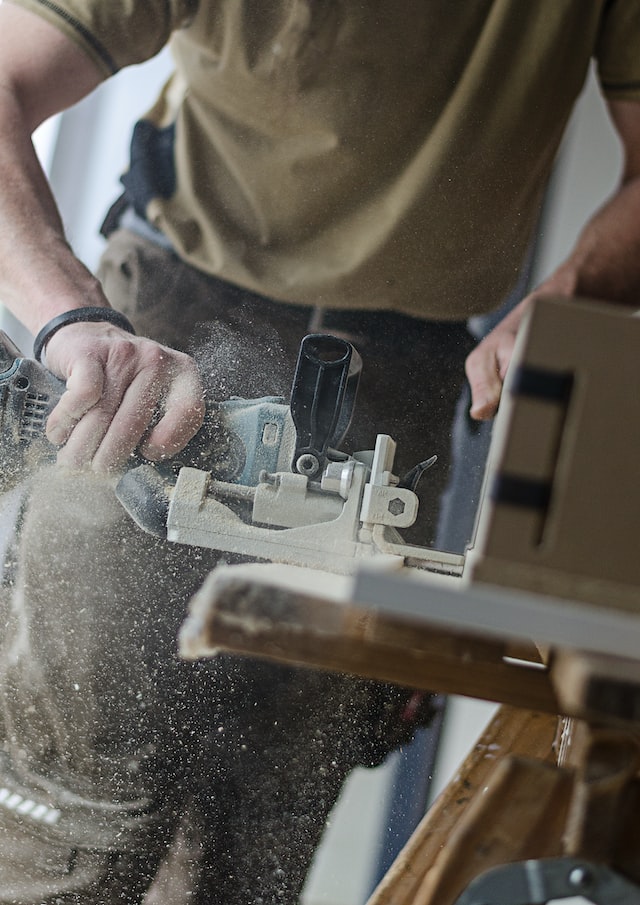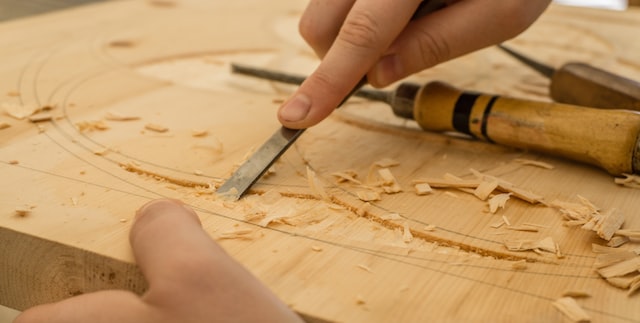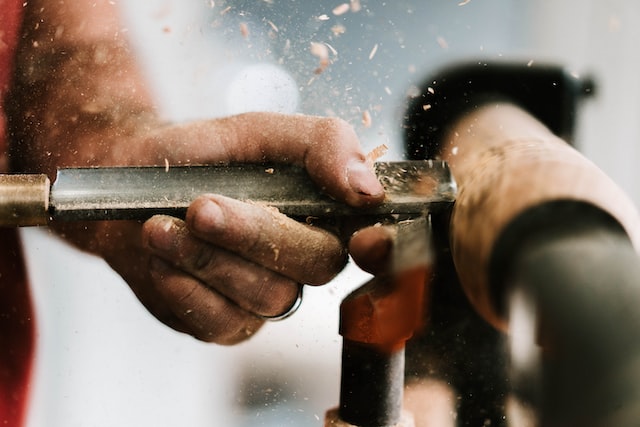You can get good results and long durability from less expensive instruments if you take care of them properly. Every skilled craftsman or carpenter should know how to properly sharpen chisels by hand and maintain it so that it lasts a long time. Using the advice contained in this piece, you may hone your skills and ensure that your tools are in top working order.
What are Chisels Used For?
Chisels are one of those small tools that almost everyone may benefit from having on hand. The professional carpenter or the do-it-yourselfer in need of a tool to open a paint can both benefit from their versatility.
Chisels purchased from a hardware store are not always in the best shape when purchased. Machines are being used to sharpen them, rather than human hands, thus the results are less than ideal.
Myths about Chisels
Just like any other product, using chisels entails some truths to believe and lies to avoid. With such, here are some myths regarding this small carpentry tool:
Chisel Myth #1: A “good enough” edge can be achieved by grinding using a power grinder.

Some tools, such as those used to split wood by wedging the fibers apart, those designed to spin quickly and endure abuse (such as lawnmower blades), and some turning tools are suitable for use straight from the grinder.
Chisels and other wood-cutting tools can be improved upon by making their edges sharper.
Chisel Myth #2: Chisels are ready to use with their razor-sharp edge.
Nope! Most high-end tools require some degree of honing before they can be used effectively, and even the cheapest tools benefit from having their sharp edges smoothed, their backs flattened, and their grinder marks removed. Consider that, typically, we either spend more money to have a person inspect the tool as it’s being made, or we spend less money to make the instrument in the first place but spend more time perfecting it.
Chisel Myth #3: Chisels are multipurpose tools that can be used to pry nails, open paint cans, and even as screwdrivers.
It’s safe to say that once you’ve spent the time to hone and polish your chisels, you’ll never want to use them on anything other than wood again.
How to Sharpen Chisels by Hand: The Characteristics of a Sharp Chisel
Chisels need to be sharp in order to work at their best! However, there are some factors that need you to define a sharp chisel from an obtuse one.
- A perfectly flat back, which suggests that it will likely need to be flattened.
- In a zero radius intersection, the bevel and the flat back meet at every point along the whole cutting edge, leaving no rounded or uneven areas.
- All of the scratches from the gritstone have been removed after the edge was fine-tuned or honed.
One of the most effective methods for determining whether or not a blade is flat is to hold it in a hand and a flat in the opposite. Evaluating the tool is a good way before purchasing chisels and plane blades. Align the straight razor on the rear of the blade, close to the cutting edge, while pointing the blade towards the light.
Check to see if any light is leaking through the ruler’s blade back by tilting the straight edge. The blade back has low spots, or it isn’t flat, as indicated by particular patches of light streaming through it. It’s possible to fix the blade, but we’d rather not waste too much time here if we can help it.
A Chisel’s Required Degree of Sharpness

Most people are under the false impression that a sharp chisel is safer than a dull one. Nevertheless, a dull chisel actually poses a greater risk due to the need for greater effort to be exerted in order for it to “operate” correctly.
Many people, including myself, shave a patch of arm hair to assess the sharpness of a chisel. This is nasty and is not always an accurate reflection of the blade’s overall sharpness. To add insult to injury, cutting paper is counterproductive since it does not put your blade to the test throughout its entire length. Aside from that, it includes micro-abrasives that will dull your blade’s edge.
A “sharp” chisel can remove an end-grain shaving of the full width of a board with only hand pressure. In addition to leaving behind scratches or obvious lines in the wood grain, a dull chisel will produce dust rather than shavings. To do this, you need to get the back nice and flat, then the bevel polished to a mirror finish at 3000 grit.
There are a lot of individuals who spend a significant amount of money and time on tools that will provide them with a 20,000-grit crystal finished edge. But, the performance of that edge will not be capable of being assessed as being any different (particularly in cheaper steel such in all of these $11 chisels) than that of the performance of the 3000 grit polished tip.
Step-by-Step Procedures on How to Sharpen Chisels by Hand
Maintaining a constant angle is essential for good honing since it ensures that each succeeding stone reaches the tool’s very tip. A few simple methods will let you keep that angle without a jig, thereby reducing the amount of time you spend sharpening.
Step 1: Tools Preparation
In preparing your tools to set you up for your activity on how to sharpen chisels by hand, you need to be aware of the different sharpening materials. Such tools are as follows:
- Abrasives like glass plates, wet/dry sandpaper, water stones, oil stones, or diamond plates
- Lube such as a spray bottle of water, oil, or honing fluid
- Cleaning tools including oil and microfiber cloths
- Diagnostic instruments like a sharp knife, magnifying glass, and straight edge
- Strokes and abrasive material
A flat diamond plate and two grit water stones make up my go-to sharpening set. Since diamond plates are naturally flat, they can be used for a wide variety of tool refurbishment tasks (including but not limited to back flattening). It’s true that they’re a touch pricy, yet, they are a superb financial commitment.
Plate glass and wet/dry sandpaper can produce a comparable outcome more affordably. If you don’t want to spend money on water stones right now, you might want to use plate glass or sandpaper to maintain them flat until you do, at which point you can upgrade to a diamond plate using progressively finer grits of sandpaper.
✔ Pre-sharpen chisels.

Intricate woodworking requires tools that are razor sharp, and a brand-new set of chisels isn’t going to cut it. Unless you use them on a regular basis, you probably won’t need to sharpen them more than once or twice a year.
✔ Get the stone ready.
Get it ready as directed by the manufacturer. Water stones require a water bath in order to be effective. You need to use the right kind of petroleum oil to lubricate an oil stone.
Step 2: Tuning up a Chisel
The next step in how to sharpen chisels by hand is to hone them. Honing the best chisels for carpentry requires the following actions:
✔ The flat side should be your starting point.
Once a chisel has been correctly honed, its flat side should reflect light like a mirror. To begin, move it lengthwise over the coarse grit on the stone, working it both back and forth. Try swiping it back and forth with both hands, but be careful to keep it steady.
Maintain a consistent rhythm with your motions rather than making sudden stops or starts. When the coarse grit of the stone has left intricate scratches across the entire flat surface, repeat the process with the medium and fine grits. Achievement of a mirror-like reflectivity means completion of this step.
✔ Establish the appropriate bevel angle with the assistance of a guide for sharpening.
Freehanding a bevel against the stone can be used to sharpen it, but it can be quite challenging to ensure that you reach the precise angle you desire without a honing guide. Put the chisel in the honing guide then fasten the screws. Chisels are best used at an angle of 20 to 35 degrees, so adjust the guide accordingly.
- Adjust the angle of your paring chisel to 20 degrees.
- At a 25-degree angle, common chisels function effectively.
- It’s standard practice to create a honing guide out of wood rather than spend money on
one. In order to secure a chisel at a specific angle, you can see a wooden wedge to the desired length. Mount the chisel holder by supergluing two wood strips together to form rails. And then, screwing the third sheet of wood over through the rails.
✔ Sharpen the bevel.

Flatten the bevel against the stone’s coarsest grit. Holding the guide with both hands, carve a thin, extended figure 8 pattern into the stone. Do that by moving the chisel backward and forth. The scratches left by the coarse grit should be visible on the bevel before switching to the medium. Finally the fine grits and wiping the blade clean in between each grit.
- In order to achieve a razor’s tip, you should use the whole stone. Too much use of one spot will cause a hollow to form. Thus, making that location less effective for sharpening in the future.
- Sometimes, when honing a bevel, the flat side will appear somewhat indented. Chisels are intentionally sharpened in Japan using a technique known as a hollow grind. This is because it makes it simpler to sharpen them again afterward.
Step 3: Alternative Finishes
The last step on how to sharpen chisels by hand is through alternative finishes. To do that, check the following guidelines below:
✔ Include a tiny bevel on the edge.
Honing is usually sufficient, but a micro bevel can make the chisels even sharper if necessary. An additional, smaller bevel is cut into the bevel’s tip. Unless you’re working with extremely precise measurements, this step is optional. To make a micro bevel, tighten the hone’s guiding angle by 5 degrees. You should consider the previous bevel and hone it again with the finest grit.
✤ If you want to make a micro bevel, all it takes is a few strokes. Do it with the finest grit and very little metal removal.
✔ Sharpen the chisel by stropping it.
Stropping is a common method of finishing that leaves the chisel shiny. Mount a leather square on a flat surface with tape. Then apply a thin, even coat of polishing compound to it. The compound should be repeatedly rubbed with the chisel’s flat side before being rubbed again with the bevel (or micro bevel). Once you’re done, clean the blade.
Frequently Asked Questions
Q: Which stone works best for honing chisels?
The simplest stones to preserve are diamonds. And, a set of diamonds is good to go to hone chisels. They never need to be prepared or flattened. To use them, just give them a quick spritz of water. And then, be sure to dry them off after you’re done sharpening.
Q: What would you use in place of a honing guide if you needed to hone a chisel?
If you want to flatten a stone, just use your sharpening stones to brush over it in a circular motion. Soaking the water stones for 10 minutes will get them ready for use. Diamond stoners receive a soap water spray, whereas oil stoners only receive a few beautiful drops of oil. Simply placing the stone on the desk will cause it to slide.
Q: Approximately how often must chisels be sharpened?
Whenever you’re working with wood, you should sharpen your tools at minimum once every two hours, and ideally every thirty minutes. Your wood carving tools’ need for sharpening depends on the steel’s grade, the wood’s density, and, of course, how frequently you use them.
Q: Do brand-new chisels require sharpening?
It’s inevitable that once you get a brand-new chisel into your home, you’ll want to get right to work sharpening it. You can probably still make cuts into the wood with a brand-new chisel, and it will be straight enough to do so, but it won’t do the kind of job you’d prefer. A brand-new chisel’s blade will need sharpening, and you may even want to add a second bevel.
Q: Is a chisel possible to hammer down on a tormek?
The flattening of the rear ends is a one-time process that remains effective for the duration of the chisel as well as the planar iron’s lifetime. It can be done in the same way you’ve always done it, or by using the Tormek grindstone’s side.
Q: Is it necessary to use a secondary bevel on chisels?
It is best to utilize a secondary bevel, often referred to as a micro or sharpening bevel, to create a flawless cut and get the most out of a bench chisel. You can expect this bevel to be about 5 degrees steeper than the primary bevel.
Q: To what extent should a chisel have a micro bevel?
In a nutshell, a Tormek does not require micro bevels. As an aid to sharpening bench stones, micro bevels are a handy tool to have on hand. The objective is to just have to conduct a light touch-up sharpening using a tiny portion of the bevel, rather than having to do a full bevel grind every time.
Final Thoughts
Perhaps the most exciting aspect of woodworking is the sensation of cutting with a newly sharpened tool. It’s as if you’ve been bestowed with a mystical ability to direct the tool with such ease that it flies through the wood. The ways how to sharpen chisels by hand are available to help you improve this carpentry tool, transforming it into a shiny, pointed jigger.


